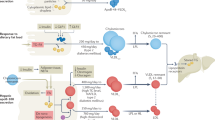Summary
Some mechanisms of the triglyceride-lowering effects of fibrates in patients with hypertriglyceridemia are reviewed. One main effect of the fibrates is the stimulation of lipoprotein lipase activities in plasma as well as in adipose tissue. According to this increase in the degradational activity VLDL catabolism is stimulated, as has been demonstrated for VLDL apo B and VLDL triglycerides. In addition, the composition of hypertriglyceridemic LDL is reverted towards normal. Furthermore, the increased degradation via the nonreceptor pathway is decreased by fibrate treatment, thus lowering the atherogenic potential of triglyceride-rich lipoproteins. But additionally the degree of postprandial hypertriglyceridemia is lowered by fibrates.
Similar content being viewed by others
References
Eisenberg S, Gavish D, Oschry Y, Fainaru M, Deckelbaum RJ (1984) Abnormalities in very low, low and high density lipoproteins in hypertriglyceridemia. J Clin Invest 74: 470–482
Saku K, Gartside PS, Hynd BA, Kashyap ML (1985) Mechanism of action of gemfibrozil on lipoprotein metabolism. J Clin Invest 75: 1702–1712
Taskinen MR, Kuusi T (1987) Enzymes involved in triglyeride hydrolysis. Clin Endocrinol Metabol 1: 639–666
Shepherd J (1989) Commentary. Cardiology 76 [Supl 1]: 42–43
Shepherd J, Packard CJ, Stewart JM, Atmeh RF, Clark RS, Boag DE, Carr K, Lorimer AR, Balantyne D, Morgan HG, Lawrie TDV (1984) Apolipoprotein A and B (Sf 100-400) metabolism during bezafibrate therapy in hypertriglyceridemic subjects. J Clin Invest 74: 2164–2177
Kesaniemi YA, Grundy SM (1984) Influence of gemfibrozil and clofibrate of metabolism of cholesterol and plasma triglycerides in man. JAMA 251: 2241–2246
Packard CJ, Clegg RJ, Dominiczak MH, Lorimer AR, Shepherd J (1988) Effects of bezafibrate on apolipoprotein B metabolism in type III hyperlipoproteinemic subjects. J Lipid Res 27: 930–938
Oster P, Schlierf G, Lang PD, Andreas A, Mühlbeyer W, Schellenberg B, Vollmar J (1979) Diurnale Lipid- und Lipoproteinprofile mit Bezafibrat und Clofibrat bei gesunden Freiwilligen und Patienten mit Hypertriglyceridämie. In: Greten H, Lang PD, Schettler G (eds) Lipoproteine und Herzinfarkt. Witzstrock, Baden-Baden, pp 148–150
Weintraub MS, Eisenberg S, Brelow JL (1987) Different patterns of postprandial lipoprotein metabolism in normal, type IIa, type III and type IV hyperlipoproteinemic individuals. Effect of treatment with cholestyramine and gemfibrozil. J Clin Invest 79: 1110–1119
Author information
Authors and Affiliations
Rights and permissions
About this article
Cite this article
Schwandt, P. Fibrates and triglyceride metabolism. Eur J Clin Pharmacol 40, S41–S43 (1991). https://doi.org/10.1007/BF01409407
Issue Date:
DOI: https://doi.org/10.1007/BF01409407




